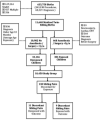Early childhood exposure to anesthesia and risk of developmental and behavioral disorders in a sibling birth cohort
- PMID: 21415431
- PMCID: PMC3164160
- DOI: 10.1213/ANE.0b013e3182147f42
Early childhood exposure to anesthesia and risk of developmental and behavioral disorders in a sibling birth cohort
Abstract
Background: In vitro and in vivo studies of anesthetics have demonstrated serious neurotoxic effects on the developing brain. However, the clinical relevance of these findings to children undergoing anesthesia remains unclear. Using data from a sibling birth cohort, we assessed the association between exposure to anesthesia in the setting of surgery in patients younger than 3 years and the risk of developmental and behavioral disorders.
Methods: We constructed a retrospective cohort of 10,450 siblings who were born between 1999 and 2005 and who were enrolled in the New York State Medicaid program. The exposed group was 304 children without a history of developmental or behavioral disorders who underwent surgery when they were younger than 3 years. The unexposed group was 10,146 children who did not receive any surgical procedures when they were younger than 3 years. Exposed children were entered into analysis at the date of surgery. Unexposed children were entered into analysis at age 10 months (the mean age at which exposed children underwent surgery). Both exposed and unexposed children were followed until diagnosis with a developmental or behavioral disorder, loss to follow-up, or the end of 2005. The association of exposure to anesthesia with subsequent developmental and behavioral disorders was assessed with both proportional hazards modeling, and pair-matched analysis.
Results: The incidence of developmental and behavioral disorders was 128.2 diagnoses per 1000 person-years for the exposed cohort and 56.3 diagnoses per 1000 person-years for the unexposed cohort. With adjustment for sex and history of birth-related medical complications, and clustering by sibling status, the estimated hazard ratio of developmental or behavioral disorders associated with any exposure to anesthesia when they were younger than 3 years was 1.6 (95% confidence interval [CI]: 1.4, 1.8). The risk increased from 1.1 (95% CI: 0.8, 1.4) for 1 operation to 2.9 (94% CI: 2.5, 3.1) for 2 operations and 4.0 (95% CI: 3.5, 4.5) for ≥3 operations. The relative risk in a matched analysis of 138 sibling pairs was 0.9 (95% CI: 0.6, 1.4).
Conclusion: The risk of being subsequently diagnosed with developmental and behavioral disorders in children who were enrolled in a state Medicaid program and who had surgery when they were younger than 3 years was 60% greater than that of a similar group of siblings who did not undergo surgery. More tightly matched pairwise analyses indicate that the extent to which the excess risk is causally attributable to anesthesia or mediated by unmeasured factors remains to be determined.
Figures


Comment in
-
Anesthetic neurotoxicity: a difficult dragon to slay.Anesth Analg. 2011 Nov;113(5):969-71. doi: 10.1213/ANE.0b013e318227740b. Anesth Analg. 2011. PMID: 22021792 No abstract available.
References
-
- Todd MM. Anesthetic neurotoxicity: the collision between laboratory neuroscience and clinical medicine. Anesthesiology. 2004;101:272–273. - PubMed
-
- Olney JW, Young C, Wozniak DF, Jevtovic-Todorovic V, Ikonomidou C. Do pediatric drugs cause developing neurons to commit suicide? Trends Pharmacol Sci. 2004;25:135–139. - PubMed
-
- Olney JW, Wozniak DF, Farber NB, Jevtovic-Todorovic V, Bittigau P, Ikonomidou C. The enigma of fetal alcohol neurotoxicity. Ann Med. 2002;34:109–119. - PubMed
Publication types
MeSH terms
Grants and funding
LinkOut - more resources
Full Text Sources
Other Literature Sources
Medical

